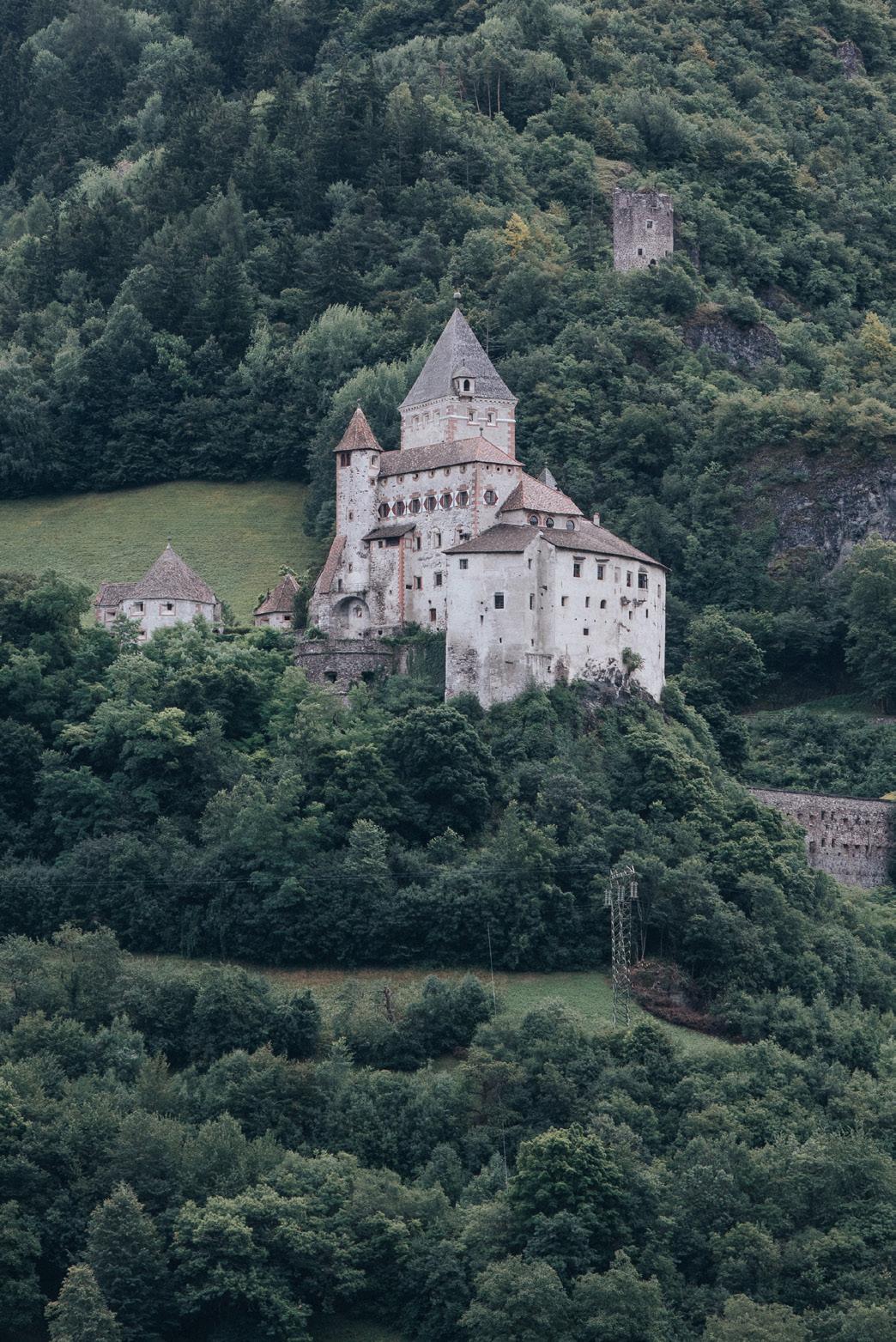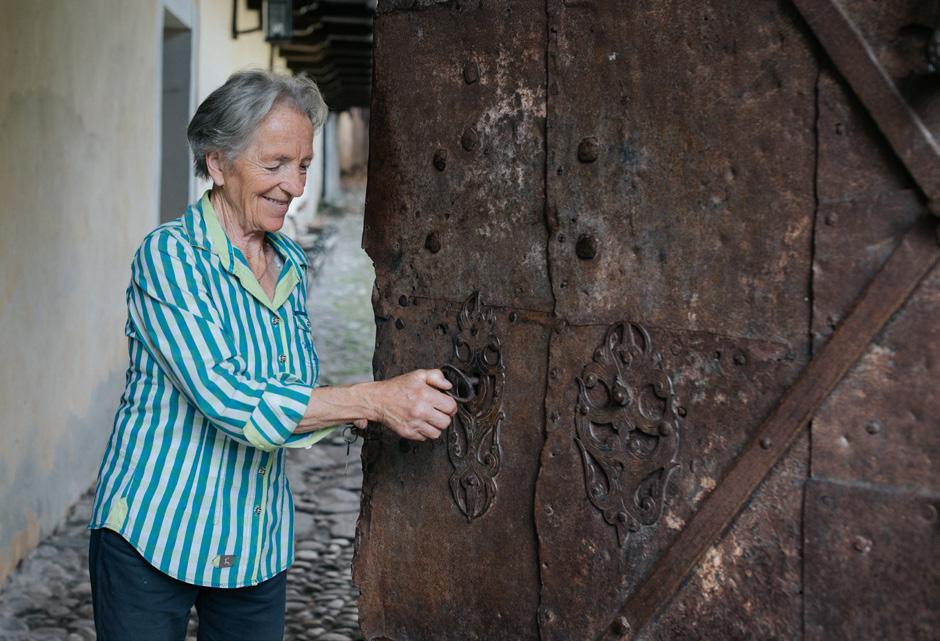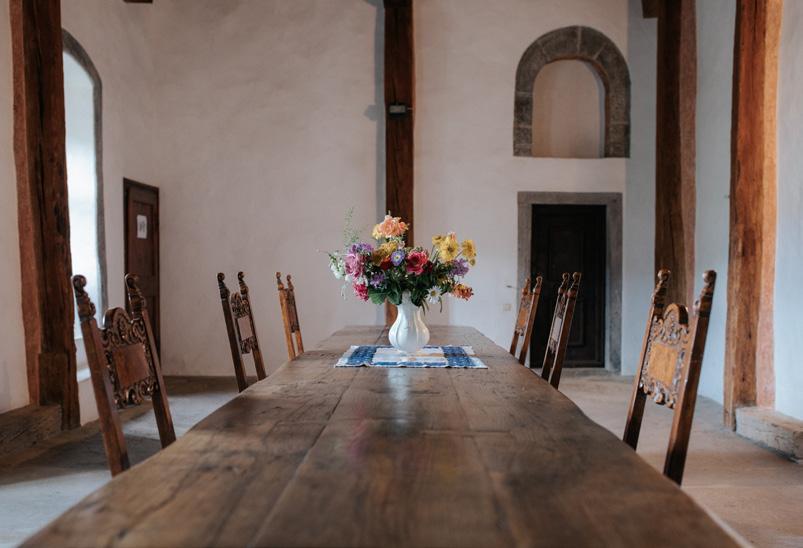
9 minute read
Is Anyone Home? Paying a visit to Terese Gröber in Trostburg Castle

Is Anyone Home?
Advertisement
Terese Gröber has lived in Trostburg Castle all her life. She takes visitors on tours within its historic walls, telling stories of the past when knights and counts still resided here
Text — LENZ KOPPELSTÄTTER Photos — CAROLINE RENZLER
S
“I feel so happy and grate- ful to live up here,” says Terese Gröber. The castle is her home.
ometimes Terese Gröber, or “Trostburg Tresl” as she is affectionately known, stands at the window of the magnificent Renaissance hall gazing down across the Eisacktal valley. It’s like looking from the past into the modern day. The stucco figures of the Counts of Wolk- enstein silently surround the old woman as she takes in the sweeping view across the villages of Barbian/Bar- biano, Lajen/Laion and Villanders/Villandro. Nestled among woodland and meadows, the clusters of build- ings seem to be clinging on to the steep slope. Down in the valley, the hustle and bustle of modern life contin- ues. Cars streak by and lights flash. It’s a frenzied world. But here, high above Waidbruck/Ponte Gardena, be- hind the thick castle walls of Trostburg everything is silent and pleasantly calm. Terese breathes out slowly. “I feel so happy and grateful to live up here,” she says. Aged 73, she has spent her whole life here. Her fam- ily once took care of the castle’s upkeep for the Counts of Wolkenstein. Today, Terese takes visitors on tours within its historic walls, recounting stories from the past when knights, barons and counts still lived here. She also tells them about how difficult life in the castle can be today, but why this won’t make her leave – the castle is, after all, her home. And would probably turn to ruin if she weren’t around.
Trostburg Castle towers 627 metres above sea lev- el, overlooking the gorge cut through the rock by the Ei- sack river over thousands of years. It dates back to the 12th century when the Lords of Velthurns resided here. Branded as bandits, they were forced to surrender the castle to the Count of Tyrol in around 1290. He in turn

gave it as a fiefdom firstly to the Lords of Villanders and eventually to the Wolkenstein dynasty, who retained it as their ancestral seat for around 600 years. The castle was extended between the 14th and 16th centuries, before Engelhard Dietrich, Count of Wolkenstein, had it remodelled in the Renaissance style in the 17th century. From then on, it was only used as a summer residence.
Terese Gröber ushers us in. As we cross the threshold, the intimidating portcullis with its wooden spikes looms above our heads. The machicolations, openings used to drop boiling water or tar on enemies in the Middle Ages, are a sombre sight to behold. The inner courtyard, in contrast, is an idyllic spot awash with the colours of pelargoniums, oleanders and the hydrangeas planted by Terese’s mother. Our eyes fall on arches, columns and a flight of stairs leading up into the interior of the castle. A wall painting depicting the family tree of the Counts of Wolkenstein adorns one of the outer walls. We spot names such as Engelhard Dietrich and the famous one-eyed troubadour Oswald von Wolkenstein.
Passing a sooty kitchen on our right and a lady’s chamber behind the next door, we enter the keep. Here the walls are two and a half metres thick, making it the perfect place to retreat in the event of danger. Our steps echo eerily. Walking through these walls is like stepping back in time to when families, numerous children, soldiers and clergymen once lived in the castle together. There’s a draught, we can hear the wind whistling. “The wind has always made its home in the castle,” says Terese, immediately going on to explain that the castle’s name “Trost” used to mean “lord”, “ruler” or even “providence” in the German spoken in the Middle Ages. She opens the door to the chapel, which squeaks and creaks. We are greeted by kneelers carved from dark, old wood, and a simple altar. The Virgin Mary looks down at us from the ceiling, the child of God in her arms. Images of Saint Anthony the Great are a recurring theme in the wall paintings. An Egyptian monk and hermit who led an ascetic life and was haunted by visions of the Devil whilst in the desert, he is regarded as the father of monks. Called “Fåckn-Toni” (“Pig Toni”) by local catholics, he is the patron saint of farmers, butchers and swineherds. “Older farmers’ wives still sometimes come up to the castle to ask if they can go into the chapel to pray for their sows’ litters,” says Terese.
She then tells us stories from her childhood, recalling how she and her siblings used to play in the woods and help in the stables. “We had to whisper in the mornings because children’s voices echo so loudly around the castle and the countess always liked to sleep late,” she remembers. The countess used to tell the children all about the world, about Italy, about the sea. Places that Terese has never seen, and has only ever dreamed of visiting. “I’ve just always loved staying here,” she says simply. However, there was once a time when it seemed impossible to stop the castle from falling into disrepair. The counts left, Terese’s parents died and her siblings all moved into the valley. Only Terese wanted to stay. But how? In 1967, members of the South Tyrolean Castles Association founded a private company to save Trostburg Castle from ruin. A few years later, Trostburg was turned into a museum and became the official seat of the association. Terese “We had to whisper in the mornings because the countess liked to sleep late.”


The keep’s walls are up to two and a half metres thick, meaning the castle was the perfect place to retreat in the event of danger.
Terese Gröber
Ripe old age The castle dates back to the 12th century. At 73 years old, Terese Gröber has spent her whole life here. Her family once took care of the castle’s upkeep for the Counts of Wolkenstein. Today, Terese takes visitors on tours within its historic walls, recounting stories from the past when knights, barons and counts still lived here.

One-eyed troubadour Oswald von Wolkenstein was part of the dynasty who owned the castle. Today, Trostburg is a museum and the official seat of the South Tyrolean Castles Association.



Hydrangeas planted by Terese’s mother still grow in the castle garden. The castle’s chapel is dedicated to Saint Anthony the Great, the patron saint of farmers, butchers and swineherds.

was allowed to stay on to take care of the castle. “Because I’m part of the castle and the castle is part of me,” she says.
In the decades since, she’s been showing visitors around her castle. When she isn’t giving tours, she keeps herself busy by cleaning, scrubbing the floors with a brush and hard soap and looking after a mare and her foal, chickens and three cats. Years ago, she explains, she used to walk down the steep, slippery stone path into the village every few days and, in any case, always on Sunday to attend the early morning mass. Now she only leaves the castle once every two weeks to go shopping for staples like bread, butter and milk. Does she ever get lonely? “Bah,” she shrugs dismissively. “Enough people come up to see me,” she says. The walk is enough to leave some would-be mountaineers out of breath and sweating by the time they reach the castle gate. Terese grins and tells us how she used to make it up and down the hill in high-heeled shoes. But now a new road is being built and plans are in place to connect the castle to the internet. “The internet, here?” she laughs.
She invites us into her living room, which is to the immediate left of the castle entrance. Here, there’s an array of religious icons and family photos as well as a ceramic stove, an old-fashioned telephone with a rotary dial and an old television set. Sometimes when the weather is particularly stormy, the power cuts out and she has to dig out a torch. And if the batteries die, she lights candles. “The internet,” she repeats, chuckling, a twinkle in her eye. One of her cats wraps herself around her legs. “I guess people are reliant on it these days. I can do perfectly without it,” she adds. When she watches the news in the evening and hears about all the troublesome things happening “down below”, she says she feels very happy to be up here. Away from it all in her very own world.

Thick Walls, Deep Gorges Other castles worth a visit
Trostburg South Tyrolean Castles Museum
+ Burgfriedenweg 22, 39040 Waidbruck/ Ponte Gardena +39 0471 654 401 Open to the public: Thursday before Easter to end of October, Tues–Sun
www.burgeninstitut.com
Velthurns Castle
+ Built as a summer residence for the Prince Bishops of Brixen/Bressanone, the castle houses one of the most exceptional examples of European inlay work from the late 16th century.
Dorf 1, 39040 Feldthurns/ Velturno +39 0472 855 525 Open to the public: March to November, Tues–Sun
www.schlossvelthurns.it
Rodenegg Castle
+ The imposing castle complex above the Rienz gorge dates from around 1140 and is among the largest fortresses in South Tyrol. The castle is still inhabited and also serves as a museum. It features a dungeon, a beautifully colourful wedding hall and an armoury. The Ywein frescoes from the 13th century are some of the oldest profane wall paintings in the German-speaking world.
Vill 1, 39037 Rodeneck/Rodengo +39 391 74 89 492 Open to the public: May to October, Sun–Fri
schloss.rodenegg@gmail.com
Mühlbacher Klause fortress
+ Driving eastwards from Brixen via Mühlbach/Rio di Pusteria it’s impossible to miss the ruins of this fortress, large parts of which are still well preserved. In the Middle Ages, Mühlbacher Klause was an important fortress and customs station. From 1271, the border created by Meinhard II between the counties of Görz (Pustertal valley) and Tyrol ran through here. The main road into Pustertal valley passed straight through the ruins until the 1990s and today a cycle route runs directly adjacent to the site.
Staatsstraße 49, 39037 Mühlbach/Rio Pusteria +39 0472 886 048 Open to the public: June to September, Mon
www.muehlbacherklause.it
Summersberg Castle
+ Towering high above the Eisacktal valley, the castle was built for defensive purposes and in the 14th century became the seat of the former court of Gufidaun/Gudon, which had a large sphere of influence extending all the way to the neighbouring Gadertal valley. In 1880, the folklorist and German scholar Ignaz Vinzenz v. Zingerle purchased the extensive castle complex. It is still inhabited today, so only the inner courtyards are open to the public.
Nafner Straße, 39043 Gufidaun/Gudon +39 0472 847 424 Open to the public: July to September, Mon (by appointment only)
www.klausen.it
More information about castles in South Tyrol: South Tyrolean Castles Association
www.burgeninstitut.com










